Related Research Articles
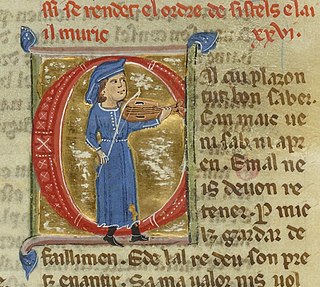
A troubadour was a composer and performer of Old Occitan lyric poetry during the High Middle Ages (1100–1350). Since the word troubadour is etymologically masculine, a female equivalent is usually called a trobairitz.
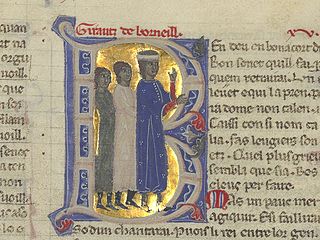
Giraut de Bornelh, whose first name is also spelled Guiraut and whose toponym is de Borneil or de Borneyll, was a troubadour connected to the castle of the viscount of Limoges. He is credited with the formalisation, if not the invention, of the "light" style, or trobar leu.
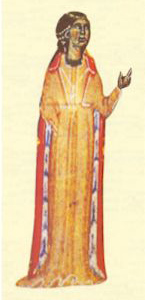
The trobairitz were Occitan female troubadours of the 12th and 13th centuries, active from around 1170 to approximately 1260. Trobairitz is both singular and plural.
Trobar clus, or closed form, was a complex and obscure style of poetry used by troubadours for their more discerning audiences, and it was only truly appreciated by an elite few. It was developed extensively by Marcabru and Arnaut Daniel, but by 1200 its inaccessibility had led to its disappearance. Among the imitators of Marcabru were Alegret and Marcoat, who claimed himself to write vers contradizentz, indicative of the incomprehensibility of the trobar clus style. Below is a sample of the style from Marcoat's sirventesMentre m'obri eis huisel, wherein the poet himself remarks on his moz clus :
The canso or canson or canzo was a song style used by the troubadours. It was, by far, the most common genre used, especially by early troubadours, and only in the second half of the 13th century was its dominance challenged by a growing number of poets writing coblas esparsas.
The sirventes or serventes, sometimes translated as "service song", was a genre of Old Occitan lyric poetry practiced by the troubadours.

Guilhem de Saint-Leidier, also spelled Guilhem de Saint Deslier, Guillem de Saint Deidier and Guilhèm de Sant Leidier was a troubadour of the 12th century, composing in Occitan. He was lord of Saint-Didier-en-Velay, was born at some date before 1150, and died between 1195 and 1200. He was said to have loved Belissende, sister of Dalfi d'Alvernha and wife of Eracle III of Polignac, Guilhem's feudal overlord.

The Comtessa de Dia, possibly named Beatritz or Isoarda, was a trobairitz.
Tibors de Sarenom is the earliest attestable trobairitz, active during the classical period of medieval Occitan literature at the height of the popularity of the troubadours.

The (Lo) Monge de Montaudon, born Pèire de Vic, was a nobleman, monk, and troubadour from the Auvergne, born at the castle of Vic-sur-Cère near Aurillac, where he became a Benedictine monk around 1180. According to his vida, he composed "couplets while he was in the monastery and sirventes on subjects that were popular in the region."

Peire d'Alvernhe or d'Alvernha was an Auvergnat troubadour with twenty-one or twenty-four surviving works. He composed in an "esoteric" and "formally complex" style known as the trobar clus. He stands out as the earliest troubadour mentioned by name in Dante's Divine Comedy and De vulgari eloquentia.
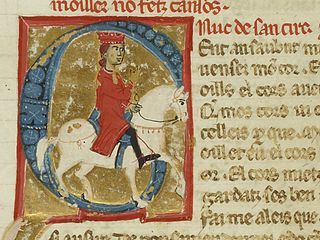
Uc de Saint Circ or Hugues (Hugh) de Saint Circq was a troubadour from Quercy. Uc is perhaps most significant to modern historians as the probable author of several vidas and razos of other troubadours, though only one of Bernart de Ventadorn exists under his name. Forty-four of his songs, including fifteen cansos and only three canso melodies, have survived, along with a didactic manual entitled Ensenhamen d'onor. According to William E. Burgwinkle, as "poet, biographer, literary historian, and mythographer, Uc must be accorded his rightful place as the 'inventor' (trobador) of 'troubadour poetry' and the idealogical trappings with which it came to be associated."
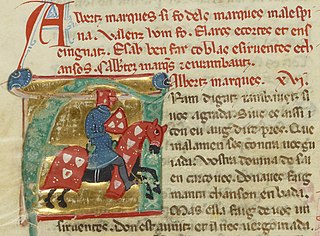
Albert Malaspina (1160/1165–1206/1212), called Alberto Moro and lo marches putanier, was a member of the illustrious Malaspina family. He was a noted troubadour and patron of troubadours. Albert disputes with Peire de la Caravana the position of earliest native Italian troubadour.
Guilhem Peire Cazals de Caortz or Guilhem Peire de Cazals was a troubadour of the first half of the thirteenth century. He was born or lived in Cahors, Quercy, from which his name "de Caortz". Eleven of his works, including one tenso, survive.
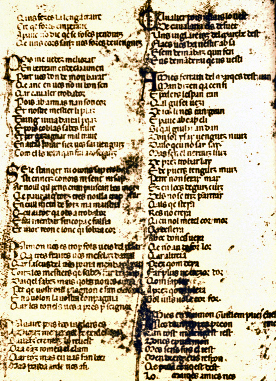
Ferrari da Ferrara, fully Ferrarino (dei) Trogni da Ferrara, was a troubadour of Ferrara in the late 13th and early 14th centuries. He was a composer, anthologist, and possibly autobiographer. He was one of the last active troubadours in Italy.
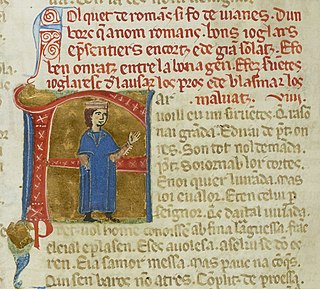
Falquetde Romans was the most famous troubadour attached to the court of Frederick II, Holy Roman Emperor, where he garnered a high reputation despite the fact that his career began as a jongleur. His surviving work consists of fourteen or fifteen pieces: seven sirventes, three tensos, two or three cansos on courtly love, a salut d'amor of 254 lines, and a religious alba. His poetry is, in general, clear and elegant, and he was apparently very religious.
Alais and Yselda were two young noble trobairitz, probably sisters or nuns, who wrote an Occitan tenso with an elderly woman named Carenza.

A torneyamen or certamen was a lyric genre of the troubadours of the thirteenth century. Closely related to the tenso, a debate between two poets, and the partimen, a question posed by one poet and another's response, the torneyamen took place between several poets, originally usually three. The first three-way tenso was initiated by Raimbaut de Vaqueiras with Ademar de Peiteus and Perdigon. These wider tensos only became known as torneyamens later. A tenso or partimen that was submitted to another troubadour for adjudication may have a poetic jutjamen (judgement) attached to it and so may be considered as a torneyamen between three. The torneyamen, like the related debate forms, was probably especially common at contests, such as floral games and puys. Many such tensos and partimens come with attached jutjamens rendered in verse, as in the example Senyer Bernatz, dues puncelhas say cited below.
Nationality words link to articles with information on the nation's poetry or literature.
References
- ↑ Bec, Pierre (1984). Burlesque et obscénité chez les troubadours : pour une approche du contre-texte médiéval (ed. bilingue ed.). Paris: Stock. ISBN 2-234-01711-4.
- ↑ "Glossário - Tençom". Cantigas Medievais Galego-Portuguesas (in Portuguese). Retrieved August 22, 2022.